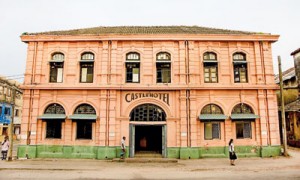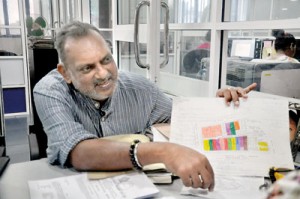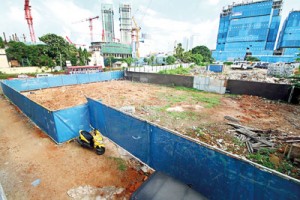News
140-year-old heritage Castle Hotel victim of US$ 400m township
View(s):Archaeology Dept’s about-face clears demolition; no compensation for owners
By Namini Wijedasa
A heritage building at Slave Island in Colombo has been pulled down to construct a US$ 400 million township by Tata Housing.
The Castle Hotel in Masjidul Jamiah Road, Kompanna Veediya, is at least 140 years old. Nothing stands at this address today. This beautiful building, erected in British colonial style, was demolished on an approval granted by the Archaeology Dept in May.

Castle Hotel the way it was: Will the same fate befall other heritage buildings as the Archaeology Dept plays Jekyll and Hyde?. Pic by Abdul- Halik Azeez
Put up by the great philanthropist Charles Henry de Soysa, Castle Hotel was tenanted to various entrepreneurs through the years. The last of them was Mahinda Perera. He (like his father, Douglas Jestus, before him) ran a working class bar there and let out the rooms upstairs.
The deeds to this property and the adjoining De Soysa Building are held by the descendants of Charles: his great-grandchildren Ranil, Malathie and the late Geethal and Jayalath. The family had once wanted to start their own development project on the site. In the ’90s, Ranil even found an American investor for it. “We could have had the first Sri Lankan twin towers there,” he said, wistfully.
But the proposals were abandoned, because the authorities repeatedly told them the building could not be touched. The tenants were once instructed in writing not to colour-wash the facade in various tones or, to change the structure of Castle Hotel, as it was of historical value. Only restorations could be permitted.
So, Ranil dreamed up a plan to convert the beautiful edifice into a “nice, decent wine bar plus British-type pub”. Granted, the building needed work. And the tenant would have had to be evicted. But it never came to that.
In 2012, President Mahinda Rajapaksa issued an order under the Urban Development Projects (Special Provisions) Act to acquire the whole lot. Further steps were taken under the law to gain possession of the land. Not only did Mr Perera have to wind up his bar operation, the de Soysas lost their property. They have not, to this day, received a cent in compensation.
Deborah Philip, an Assistant Lecturer at the History Dept of the University of Colombo, was concerned about what would become of Castle Hotel, after the takeover. The area was earmarked for a US$ 400 million mixed development project by Tata Housing. The company had already cleared adjoining lands to erect housing for families evicted to make way for the township.

Ranil de Soysa shows plans of de Soysa properties in Kompanna Veediya. Pic by Athula Devapriya
In February 2016, she wrote to the Archaeology Dept, retracing the history of Castle Hotel. Local knowledge has it that, the building was first associated with Cave & Co., a well-known Colombo enterprise founded by H.W. Cave who arrived in Ceylon from England in 1872. “The present tenants have, however, verified they transformed the building into a hotel in 1875, which would mean the building is at least 141-years-old,” she pointed out.
Ms Philip confessed in her letter that, efforts to find out what would become of Castle Hotel had proved futile. There was talk that Tata Housing will use it as an office space for employees. This would require them to carry out extensive renovations to make it more habitable.
“The present tenants informed me that, in the past, the Dept of Archaeology has visited Castle Hotel and given them specific instructions, as to what kind of repairs they could or, could not do, due to the archaeological and historic value of the building,” Ms Philip told the Dept.
In response to her appeal it be listed under the Antiquities Act, the Archaeology Dept sent a team to inspect the building. In June 2016, Director General Senerath Dissanayake wrote to the Urban Development Authority (UDA)–the agency overseeing the Tata Housing project–saying his officers have determined that the 141-year-old Castle Hotel must be preserved.
“Its architectural style appears to belong to the British colonial era,” Dr Dissanayake told the UDA. “As such, when this building is being developed by the Tata project, I request that instructions be given to the relevant institution, not to make any alterations that would damage its historic and architectural value.”
But, in May 2017–amidst torrential rains, floods and landslides–the Castle Hotel was taken down. This week, the UDA said the Archaeology Dept had issued written permission for the edifice to be demolished. The latter confirmed it. Between June 2016 and May 2017, the Dept took no steps to gazette Castle Hotel as a protected monument. So, there was nothing standing in the way of it being razed to the ground.
Under the law, any monument constructed before March 2, 1815, is automatically protected. Something erected after that date needs to be gazetted by the relevant minister. Despite its initial assessment that Castle Hotel deserved to be preserved, the Archaeology Dept reversed its decision.
Tata Housing, meanwhile, absolved itself of responsibility. A spokesman said the project was still in a planning state and the company has not started any work on the site. This is correct. The mixed development part of the Slave Island initiative falls under Phase II, which is yet to receive the necessary approvals for construction.
The UDA says the paperwork is on the verge of being completed. It claimed that, the first two floors of whatever Tata erects on the Castle Hotel plot will possesses the same facade and aesthetics of the old building. Every line and angle was measured and recorded before it was torn down, insisted Prasad Ranaweera, UDA Director (Project Management). The new designs were made in close consultation with the Archaeology Dept.

The cleared site of Castle Hotel. Pic by Indika Handuwala
Mr Ranaweera also said the Castle Hotel was “decayed and about to tumble down”. “It was like a hellhole inside,” he maintained. “It was not maintained for years by the tenants. There was nothing even to salvage. It would have collapsed.”
The Sunday Times could not obtain independent verification that the building was structurally weak. But an independent source did confirm that, “There is a proposal in the new development to accommodate the same architecture and facades.”
Curiously, Mr Ranaweera said he never received Dr Dissanayake’s letter instructing the UDA of the historic and architectural value of Castle Hotel. He only got communication saying the demolition could go ahead as the relevant building was not a listed monument.
| AIA requirement: None ordered, none done Sri Lanka’s law requires that an Archaeological Impact Assessment (AIA) be done in respect of every development project to be carried out on land exceeding 0.25 hectares in extent. The Tata Housing project in Slave Island clearly qualifies–but no AIA was ordered or, done. These surveys are carried out to determine whether there are antiquities on the land, to gauge the impact of the project on these antiquities and to recommend alternatives. These provisions are contained in the orders made by the Minister of Cultural and Religious Affairs under the Antiquities Ordinance and gazetted in April 2000. They are cited as Project Procedure Orders No 1 of 2000. The written permission of the Archaeology Dept should be taken before any project over 0.25 hectares is implemented. The development of transport systems and construction of housing complexes is included. But the UDA official in charge of the Tata Housing project said this week that, he was not aware of such a requirement. Prasad Ranaweera, Director (Project Management) said all approvals had been obtained in keeping with UDA guidelines for Phase I of the project. It was the responsibility of the Legal division to inform him if an AIA was required–and that was not done. Among those to be gazetted are protected monuments such as the Accident Ward of the Colombo National Hospital and the Rajya Osu Sala in Town Hall. But, not all buildings that are over 100 years qualify automatically to be protected monuments, clarified Prof P.B. Mandawala, the new Director General of Archaeology. The edifices in Slave Island and Fort will be surveyed, Prof Mandawala vowed. But it was too early for him to give a full account of what had been done in the past. If an AIA had not been carried out as regards the Tata project, however, the Archaeology Dept would be within its rights to file legal action, after determining the facts of the case. | |

